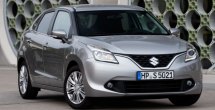|
|
Suzuki Baleno
|
 |
|
|
Debut: 2015
Maker: Suzuki
Predecessor:
No |
|
|
|
Published
on 7
Dec 2015
|
All rights reserved.
|
|
|
"We set our sights
on developing the ideal hatchback, one that makes no compromises,
giving it an elegant, sophisticated and grown-up character…” said
Kunihiko Ito.
What a bold statement! Ito is a chief engineer of Suzuki, and the car
he referred to is the new Baleno. It is not the first time Suzuki
employs the name Baleno. As I remember, the first Baleno was a compact sedan built in the
mid-1990s, but you can forget it because the new Baleno has nothing in
common. It is a B-segment hatchback, being slightly larger and
positioned higher than the existing Swift. While it is produced in
India like many other cheap Suzukis, it is not as cheap. As revealed by
the statement of Ito, it tries to be seen as modern, sophisticated and
upmarket, breaking away from the tradition of Suzuki small cars. In
other words, it wants to be the Japanese version of VW Polo. Is it that
good?
Judging from the styling I would say the claim is marginal at best.
Although Suzuki calls its design theme as “Liquid Flow”, it doesn’t
flow into our hearts. There is some style up front, but the way its
waist line flows up and down is counterproductive to aesthetic. The
thick black window frames don’t help visual quality, too. Ditto the
cheap taillights which are so ugly that I prefer to skip its pictures
here. Why can’t the Suzuki design team repeat the nice job of Swift?
More positive is the
underpinning. It sits on a new generation platform that will also form
the basis of the next Swift. Its chief achievement is lightweight,
which is claimed to be 15 percent lighter than the class norm. Don’t
believe? A Baleno with 110 hp engine weighs only 905 kg. A similarly
powerful Opel Corsa weighs 1124 kg. It also claims to be 10 percent
stiffer than the current class norm, though which car it benchmarked
is unknown.
By class standard, its size is quite generous. The 2520 mm
wheelbase is among the longest. Moreover, the Baleno’s boxy shape and
the Japanese company’s traditional know-how of squeezing maximum
interior space out of limited exterior size should not be
underestimated. Open the doors, yes, you will find an unusually
spacious cabin. Four adults are no problem, while the fifth is possible
for a brief ride. The boot is also incredibly large at 355 liters, more
than a Ford Focus (not Fiesta)!
The interior design is simple to the extent of Spartan. Plastics are
hard and roughly grained, but at least the IT features are modern. The
infotainment system has a decent 7-inch touchscreen,
whereas sat nav, Bluetooth and reverse camera are standard.
Surprisingly, it also gets an advanced engine. The 1.0 Boosterjet is a
modern turbocharged 3-cylinder with direct injection. It produces a
good 110 hp and 125 lbft of torque, enabling brisk performance for the
lightweight Baleno. Although the motor is not as rev-happy as Ford 1.0
Ecoboost, it is tractable and smooth. Like the Ford engine, it skips a
balance shaft for extra counter weights at the crankshaft and an
upgraded engine mount to dampen vibration, which is quite effective.
Cruising on highway, the Baleno’s cabin is also quite well insulated
from wind and road noise. Only at high rev the engine noise becomes
intrusive.
The 5-speed manual gearbox
that the 1.0 turbo works with has long throws and stiff gearchanges.
The alternative 6-speed automatic is a better option.
Another engine choice is the conventional 1.2 Dualjet with 90 hp. To
boost fuel economy, Suzuki also offers its mild hybrid system from the
domestic Wagon R, which utilizes a 2kW starter-alternator and a small
Li-ion battery to capture brake energy and assist acceleration.
The car rides on conventional MacPherson struts and torsion-beam
suspensions. By European standards, its handling and ride is poor.
Tuned to favour comfort, its suspension allows excessive body roll in
corners (the high sitting position doesn’t help this feel), while
understeer comes early as expected. The electrical steering feels numb,
failing to engage the driver. The soft damping absorbs big bumps, but
up the pace and the car bounces a lot. Strangely, its ride and handling
is nowhere near the level of Swift, which is a shame. Being boring to
look and to drive, this car is hard to recommend. Ito san, sorry, we
can’t agree with you.
|
Verdict:   |
|
|
|
|
|
|
|
|
|
Baleno
1.2 Dualjet
|
2015
|
Front-engined,
FWD
|
| Steel monocoque |
| Mainly steel |
| 3995 / 1745 / 1470 mm |
| 2520 mm |
Inline-4
|
| 1242 cc |
DOHC 16 valves, VVT
|
| - |
-
|
| 90 hp |
88 lbft
|
5-speed manual
|
F: strut
R: torsion-beam
|
| - |
175/65R15
|
865 kg
|
112 mph (c)
|
11.6 (c)
|
-
|
|
Baleno
1.0 Boosterjet
|
2015
|
Front-engined,
FWD
|
| Steel monocoque |
| Mainly steel |
| 3995 / 1745 / 1470 mm |
| 2520 mm |
Inline-3
|
| 998 cc |
DOHC 12 valves
|
| Turbo |
DI
|
| 110 hp |
125 lbft
|
5-speed manual
|
F: strut
R: torsion-beam
|
| - |
185/55R16
|
905 kg
|
124 mph (c)
|
9.6 (c) / 9.8*
|
29.5*
|
|
|
|
|
|
|
Performance
tested by: *Autocar
|
|
|
|
|
|
|
|
|
|
General models

|
|
|
|
Copyright©
1997-2016
by Mark Wan @ AutoZine
|
|